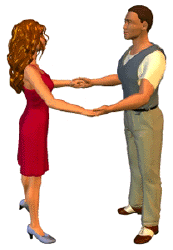Leading and Following in Open Positions
Exercise 1: Stationary Push and Pull

Stand facing your partner with a two-hand connection. This exercise is to be done while standing in place, so stand in a sturdy position with feet apart at approximately shoulders' distance. Do not move your feet at any point during the exercise.
Elbows should be held low, slightly in front of and outward from the hips. The forearms should extend straight forward from the elbows, roughly parallel to the floor. Leader's palms should be turned upward; followers palms turned downward. The connection is sturdy but not heavy, without any squeezing or gripping of the partner's hands.
1. Push
Establish a push connection. To achieve the
feeling of push, you and your partner should shift your weight towards each other to the point that you can feel each other's body weight working forward through the connection. Keep the connection consistent, and hold it for a few seconds.
2. Pull
Establish a pull connection. To achieve the feeling of pull, you and your partner should shift your weight away from each other to the point that you can feel each other's body weight working away from the connection. Keep the connection consistent, and hold it for a few seconds.
3. Repeat
Switch back and forth between a push connection and a pull connection, holding each connection for approximately 3 seconds. Be consistent and predictable with your intervals. Don't switch back and forth quickly. If you prefer to use music, hold each connection for 1 full measure (4 beats) before switching.
Remember to maintain the position of the
arms so that the elbows don't compress backwards behind the body, or extend or straighten too far in front. Don't lean or pitch your body forward or backwards, and don't use the arms to shove or tug your partner.
Lead & Follow
The leader should now call the shots. Begin again in an open facing position with a two-hand hold, but without any weight connection. When ready, the leader will try to establish a connection, and the follower must reciprocate. The leader may now make decisions about when and how quickly to change the connection from push to pull (or vice-versa), and it is up to the follower to feel the changes and respond.
LEADER: Don't be too predictable with your changes. To ensure that your partner is really following you, change the connection at very inconsistent intervals. Sometimes change the connections quickly; other times hold the connection for many seconds before changing. If your partner is having difficulty following, slow down and wait for the correct response before changing the connection again.
FOLLOWER: Your job is to pay close attention to the direction of your partner's weight, and then reciprocate. If you feel your partner's weight coming toward you, don't back up... shift your weight forward in order to counterbalance. Likewise, if you feel your partner's weight shifting away, don't follow by moving toward him... shift your weight backwards in order to counterbalance.
More Ideas
After you've become comfortable with this exercise using a two-hand hold, try it again with only a one-hand hold. The most important one-hand connection to practice is the basic RH-LH connection, but you can also practice using other connections such as LH-RH, or handshake hold (RH-RH or LH-LH).
It's also a good idea to switch roles, so that the leader learns how to follow and the follower learns how to lead. You can learn a lot more about your own part by looking at it from the perspective of your partner.

